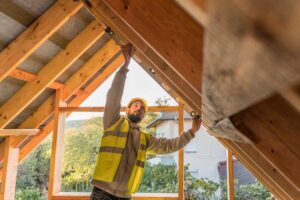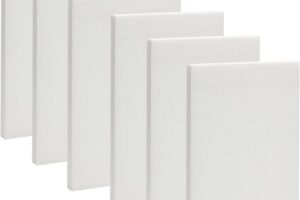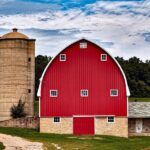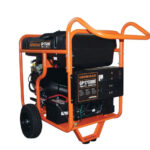Table of Contents
Foam board insulation, also known as rigid panel insulation, is a popular choice for insulating buildings due to its high insulating value per inch and its versatility in application.

This article explores in detail the role of foam board insulation in pole barn constructions, examining its benefits, installation process, comparison with other insulation methods, maintenance, longevity, and environmental impact.
Types of Foam Board Insulation
There are three main types of foam board insulation: expanded polystyrene (EPS), extruded polystyrene (XPS), and polyisocyanurate.
Each type has its unique properties and applications. EPS is the least expensive option and has the lowest R-value (insulating value) per inch.
XPS is mid-range in both cost and R-value, offering a good balance between performance and price. Polyisocyanurate is the most expensive option but offers the highest R-value.
Benefits of Foam Board Insulation
High R-Value
Foam board insulation offers a high R-value per inch, which is a measure of thermal resistance.
This means it provides excellent insulating performance in a compact form, making it ideal for applications where space is limited.
Moisture Resistance
Unlike some other types of insulation, foam board is highly resistant to moisture. This makes it suitable for use in damp environments or in buildings where condensation is a concern.
It can help prevent problems such as mold growth and structural damage caused by moisture.
Easy Installation
Foam board insulation is lightweight and easy to handle, making the installation process straightforward.
It can be cut to fit any space, allowing for a precise fit that maximizes its insulating effectiveness. This versatility makes it a practical choice for a wide range of applications.
Durability
Foam board insulation is known for its durability. It maintains its shape and insulating value over time, unlike some other types of insulation that can settle or compress.
This means that once it’s installed, it continues to provide effective insulation for many years with minimal maintenance.
Improved Energy Efficiency
By reducing heat transfer and preventing air leaks, foam board insulation can significantly improve a building’s energy efficiency.
This can result in lower energy bills and less reliance on heating and cooling systems, making it a cost-effective choice in the long run.
Versatile Use
From walls and roofs to floors and basements, foam board insulation can be used in virtually any part of a building. Its flexibility and adaptability make it a go-to solution for various insulation needs.
Soundproofing Qualities
While not primarily designed for this purpose, foam board insulation also offers some soundproofing benefits.
It can help reduce the transmission of noise from outside, contributing to a quieter and more comfortable interior environment.
Foam Board Insulation and Pole Barns
Role of Insulation in Pole Barns
Insulation plays a crucial role in pole barn construction.
It helps maintain a comfortable interior temperature, reduces energy consumption, and prevents condensation, which can lead to mold growth and structural damage.
Foam board insulation, with its high R-value and moisture resistance, is particularly well-suited for this purpose.
Installing Foam Board Insulation in Pole Barns
Installing foam board insulation in a pole barn involves several steps. First, the correct type and thickness of insulation must be chosen based on the building’s specific needs.
The insulation is then cut to fit between the framing members and secured in place. In some cases, a layer of sheathing is added over the insulation for extra protection and stability.
Foam Board vs. Fiberglass Insulation
Fiberglass insulation is another common choice for pole barns. While it’s cheaper than foam board insulation, it has a lower R-value per inch and is less resistant to moisture.
Furthermore, fiberglass insulation can be challenging to install correctly, and gaps or compressions in the insulation can significantly reduce its effectiveness.
Foam Board vs. Spray Foam Insulation

Spray foam insulation offers the highest R-value per inch of all insulation types and creates an air seal that can improve energy efficiency.
However, it’s the most expensive option and requires professional installation. In contrast, foam board insulation is more affordable and easier to install, making it a popular choice for many pole barn owners.
Foam Board vs. Cellulose Insulation
Cellulose insulation is an eco-friendly option made from recycled newspaper. It’s typically cheaper than foam board insulation but has a lower R-value per inch.
It also tends to settle over time, reducing its insulating effectiveness. On the other hand, foam board insulation maintains its shape and insulating value over time.
Foam Board vs. Mineral Wool Insulation
Mineral wool insulation, also known as rock wool or slag wool, is fire-resistant and soundproof, making it an excellent choice for certain applications.
However, it’s more expensive than foam board insulation and has a lower R-value per inch. It can also be difficult to install without causing gaps or compressions, which can reduce its insulating effectiveness.
Foam Board vs. Cotton Insulation
Cotton insulation, like cellulose, is an eco-friendly option made from recycled materials—in this case, denim. It’s safe to handle and install but is one of the most expensive insulation options.
It also has a lower R-value per inch than foam board insulation and can absorb moisture, which can lead to mold growth and reduced insulating effectiveness.
Maintenance and Longevity of Foam Board Insulation
Caring for Foam Board Insulation
Foam board insulation requires little maintenance once installed correctly.
It’s important to ensure that the insulation remains dry, as prolonged exposure to moisture can degrade the foam and reduce its insulating value.
Regular inspections should be conducted to check for any signs of damage or wear.
Lifespan and Replacement of Foam Board Insulation
The lifespan of foam board insulation depends on several factors, including the type of foam, the conditions of use, and the quality of the installation.
On average, foam board insulation can last up to 50 years if properly maintained.
When replacement is necessary, the old insulation can usually be removed and recycled, and new insulation installed in its place.
Environmental Impact of Foam Board Insulation
Sustainability of Foam Board Insulation
While foam board insulation is made from non-renewable resources, its long lifespan and high insulating value can contribute to its overall sustainability.
Many types of foam board insulation are also recyclable, which can reduce their environmental impact at the end of their life.
Energy Efficiency of Foam Board Insulation

Foam board insulation significantly improves the energy efficiency of a pole barn by reducing heat transfer and preventing air leaks.
This not only saves energy but also reduces the building’s carbon footprint.
Production and Disposal of Foam Board Insulation
The production process of foam board insulation involves the use of chemicals and consumes energy, contributing to its environmental footprint.
However, many manufacturers are adopting more sustainable practices, such as using recycled materials and reducing waste.
When it comes to disposal, while some types of foam board insulation are recyclable, others may end up in landfills.
Therefore, proper disposal methods should be followed to minimize environmental impact.
Conclusion
In conclusion, foam board insulation is a valuable choice for pole barn construction due to its high R-value, moisture resistance, ease of installation, durability, and energy efficiency.
Its versatility allows it to be used in various parts of a building, from walls to floors. Additionally, it provides some soundproofing benefits, contributing to a comfortable interior environment.
By choosing foam board insulation, you’re opting for a sustainable, cost-effective solution that can enhance the comfort and efficiency of your building for years to come.









